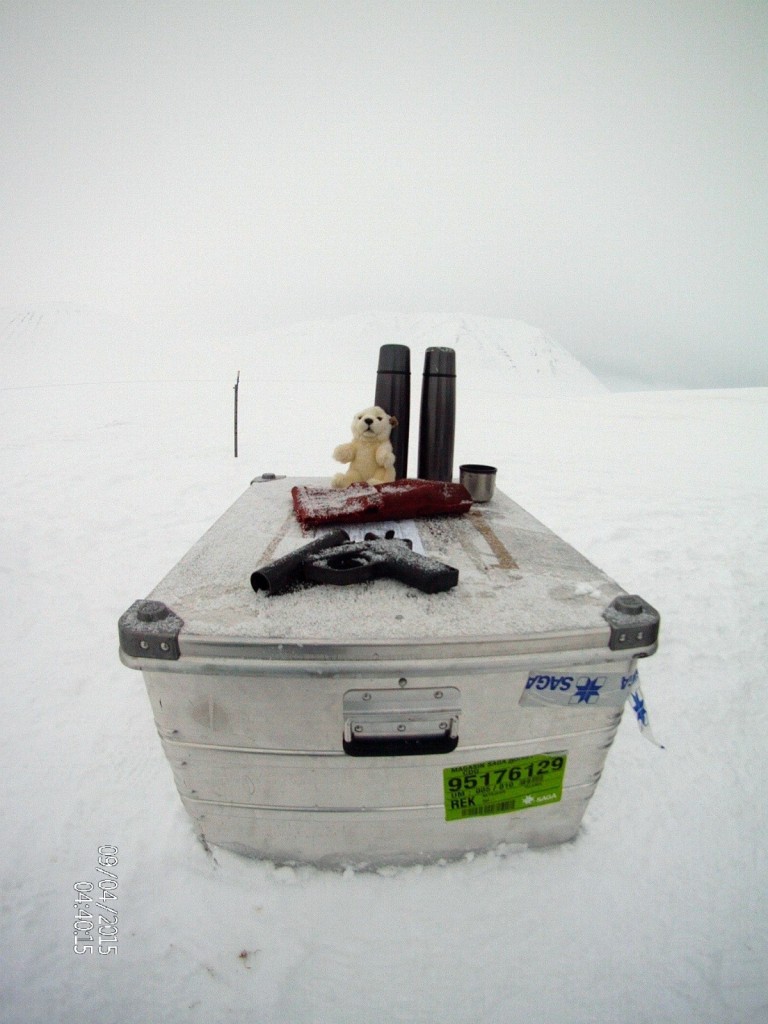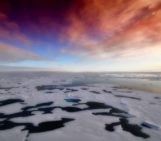
In early April 2015, a small team of 2 Belgian and 2 French researchers went to Svalbard. The goal? Testing new methods to measure sea-ice thickness and ice algal biomass, but also measuring greenhouse gases in the sea ice in relation with the ‘STeP’ (Storfjorden Polynya multidisciplinary study) campaign. With funding from the French Polar Institute (IPEV) and IPSL and logistical arrangements by the Laboratoire d’Océanographie et du Climat (LOCEAN, Paris), we had the opportunity to conduct a short field campaign, long enough to perform instrumental tests and ice coring.
The expedition was arranged with Stefano Poli – a tourist guide in Svalbard. People and equipment were driven on snow-mobiles to Agardhbukta, 100 km South East of Longyearbyen. The conditions for this expedition were quite rudimentary; a tent, a burner and sleeping bags. There are no human settlements in this remote location, so Stefano chose a camping spot, as safe as possible with respect to polar bears, right in front of the fjord, our working place…
Quite exciting, isn’t it? Let’s take a look at what we got up to:
Setting up the Camp
How do you set up a camp in the Arctic? First, you look for a hidden place, ideal for bear watching (in our case we chose a place with a small hill on our back and open on a wide and flat area). Then the hard work starts:
- Build the body and the membrane of the tent.
- Dig a hole in the snow right under the entrance to allow carbonic gases to escape.
- Set up the oil burner circuit: the oil tank positioned outside the tent is sent to the burner through a pipe covered by snow to avoid spilling accidents, and another pipe made from superposition of aluminum cylindrical cans links the burner to the air above the tent. A hole in the membrane of the tent is designed for that purpose.
- Circle the tent with a bear alarm. This was totally handmade and consisted of a gun firecrackers guided by a thread, not really sufficient to stop a polar bear!
The daily life
Eating, sleeping, working, everything was adapted to Arctic conditions. The meals – morning, lunch and dinner – were just dry food in hermetic bags that you fill in with boiling water. Better choose the orange bags, chili con carne is the best. To sleep, reindeer skins were placed directly on the ground (i.e. snow) as mattresses, and sleeping bags were in natural bird feathers. The ideal position is when you find the perfect distance between your feet and the burner.
As the bear alarm might not be totally reliable, our guide offered us (well, without the possibility to decline or give up) a memorable nocturnal experiment, a series of 2-h bear-watching shifts, with a survival kit consisting of a flare gun, 2 tea thermos and 1 teddy polar bear for superstition.
In the Field
The objectives of this short campaign were (i) to sample early spring sea ice, snow and seawater in the Storfjorden region; (ii) to calibrate non-destructive methods for ice thickness and biomass retrievals in sea ice; and (iii) to measure greenhouse gases in sea ice in relation with the ‘STeP’ campaign. This cruise is scheduled for next summer in Storfjorden, led by IPSL-Paris and involves paleo-oceanographers, physical and chemical oceanographers as well as biogeochemists from several countries.
Why is it so important to develop a non-destructive method while working on sea ice? Because the general and only way known currently to sample sea ice in its entire thickness consists of coring, which destructs the site and can alter sea ice biogeochemical conditions.
With these goals in mind, the initial plan was to operate 2 or 3 stations per day on coastal landfast ice in Storfjorden. Agardhbukta was chosen for its situation (not too far from Longyearbyen) and as one of the locations in Storfjorden where we had good expectations to find practicable sea ice in this season, which was required to carry out our work. Our guide Stefano mentioned he saw a satellite image with new sea ice on March 23 in that location. And indeed, the sampled ice was probably not older than 2-3 weeks (Figure 4). Regarding the sampling planning, our expectations where a little bit overestimated. The weather conditions were so snowy and windy that we hardly had the time to sample one full station a day… This is how Polar Regions surprise us.
Edited by Sophie Berger and Nanna Karlsson
Marie Kotovitch is a PhD student at the Chemical Oceanography Unit, University of Liège, supervised by Bruno Delille. She is working with sea ice and gas transport (mostly greenhouse gases like CO2 and N2O). She has a collaboration with the Laboratory of Glaciology at the Université Libre de Bruxelles and was involved in this campaign in Svalbard to analyze the biological aspect of this study.








Audrie Bemrich
The text in your post seem to be running off the screen in Chrome. I’m not sure if this is a formatting issue or something to do with internet browser compatibility but I thought I’d post to let you know. The design and style look great though! Hope you get the problem fixed soon.
Laura Roberts-Artal
Dear Audrie,
Thank you for alterting us to this problem. Could I ask you to take a screenshot and email it to networking@egu.eu so we can look into the problem further.
Thanks in advance.
Laura
(EGU Communications Officer)
Pingback: Cryospheric Sciences | Image of the Week — Arctic porthole, Arctic portal
Pingback: Cryospheric Sciences | Of Polar Bears and Sediment Cores: a Scientific Cruise in the Arctic